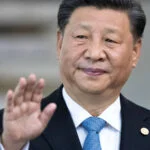Images of North Korea’s most recent round of missile launches, which included an ICBM, have been made public as the country has denounced recent military exercises involving South Korea and the United States as “open provocation and dangerous war drills” to which it must react.
According to a declaration by the Korean People’s Army General Staff, North Korea would keep responding to military drills by South Korea and the US with “sustained, resolute and overwhelming realistic military measures,” the official Korean Central News Agency (KCNA) stated on Monday.
In reaction to Pyongyang’s missile tests, South Korea and the US expanded their Vigilant Storm air drills from five to six days last week, during which North Korea launched numerous missiles, including what may have been an ICBM that failed, cruise missiles, and numerous artillery shells.
According to the KCNA article, the North Korean military described the maneuvers as “a deadly war drill of very high aggressive type” and an “open provocation aimed at purposely raising the tension.” Vigilant Storm featured a large number of US and South Korean fighter jets, including B-1B bombers. Since December 2017, B-1B aircraft hadn’t travelled to the Korean Peninsula.
According to KCNA, the North Korean army claimed to have practiced different strikes against their air bases, aircraft, and a significant South Korean city to “smash the enemies’ persistent war hysteria.” If Kim Jong Un, the leader of North Korea, had directed the launches was not mentioned.
On November 2, it acknowledged launching two ostensibly nuclear-capable “strategic” cruise missiles in the direction of the waters around Ulsan, a South Korean coastal city in the southeast.
On that day, North Korea launched about 23 missiles; one of them, for the first time since the armistice that ended the Korean War in 1953, landed 26 kilometers (16 miles) south of the Northern Limit Line, which acts as a maritime border between the two Koreas.
Two “tactical ballistic missiles loaded with dispersion warheads” were also launched as part of the operations. A “special functional warhead paralysing the enemy’s operating command system” was tested as well as an “all-out combat sortie” involving 500 fighter fighters.
North Korea typically responds angrily to joint US-South Korean drills because it perceives them as invasion training.
According to experts, Pyongyang is especially sensitive to exercises like Vigilant Storm since its air force, which is one of its poorest components due to a lack of modern jets and highly trained pilots, is one of the most vulnerable in the country’s armed forces.












